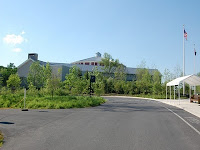Where has this guy been for two months?! Not roving, I’ll tell you that much. A couple of weeks got shot down when we moved from Hagerstown, MD up to Mechanicsburg, PA. No offense, Maryland, but we like it a lot better up here in Yankee-land. Besides, now I’m only a twenty minute drive from the AHEC!
 The rest of the time I’ve been finishing up the manuscript for the book on the 509th Parachute Infantry. When I say “finishing up” I mean editing, which seems like it’s taking as long to do as it did to write the book. We are also now in the layout stage, which means formatting and putting in pictures and maps. All very exciting. I’ll tell you more about that later.
The rest of the time I’ve been finishing up the manuscript for the book on the 509th Parachute Infantry. When I say “finishing up” I mean editing, which seems like it’s taking as long to do as it did to write the book. We are also now in the layout stage, which means formatting and putting in pictures and maps. All very exciting. I’ll tell you more about that later.In the meantime, Sheila and Meaghan convinced me to take a day off a couple of weeks ago, so we went for a drive over to Lititz, Pennsylvania, “Lancaster County’s Sweet Spot.” Lititz is a charming (yes, I said charming) little town about ten miles north of Lancaster. Our first destination: The Julius Sturgis Pretzel Bakery.
 In 1861, Julius Sturgis established the first pretzel bakery in the New World. It says so on the plaque outside, dedicated by the National Pretzel Bakers Institute. So you know it’s true. Go early, it’s a popular tour and worth it. Our tour guide, Ivy, was very knowledgeable, articulate, and friendly. During the presentation, that lasts about 30 minutes or so, the tour group gets a lesson in how to twist a pretzel. I think “hands on” history is great. And fun too. But it probably wasn’t for the 19th century pretzel makers who had to stand there twisting pretzels all day. After the tour, stop by the shop and pick up a bag for the way home. They also have fresh baked soft pretzels for sale, my favorite.
In 1861, Julius Sturgis established the first pretzel bakery in the New World. It says so on the plaque outside, dedicated by the National Pretzel Bakers Institute. So you know it’s true. Go early, it’s a popular tour and worth it. Our tour guide, Ivy, was very knowledgeable, articulate, and friendly. During the presentation, that lasts about 30 minutes or so, the tour group gets a lesson in how to twist a pretzel. I think “hands on” history is great. And fun too. But it probably wasn’t for the 19th century pretzel makers who had to stand there twisting pretzels all day. After the tour, stop by the shop and pick up a bag for the way home. They also have fresh baked soft pretzels for sale, my favorite. I admit that I had forgotten that the Wilbur Chocolate factory was in Lititz. That turned out to be a pleasant surprise. I had seen Wilbur featured on one of the Travel Chanel shows. They weren’t kidding, the chocolate is better than Hershey’s, in my humble opinion. So from the Sturgis Pretzel Bakery it is worth a stroll through Lititz a few blocks to the house of chocolate. For over 125 years, Wilbur has been making chocolate in Lititz. Their signature product is the “Wilbur Bud” (not to be thought of as the other guy’s “kiss,” this is waaaay better!). Admittedly, the majority of the square footage in Wilbur’s is devoted to the store. But in the back there is a viewing window where you can watch the chocolate treats being made. On the way is a self-service museum of sorts with lots of antique kitchen utensils and Wilbur ephemera on display.
I admit that I had forgotten that the Wilbur Chocolate factory was in Lititz. That turned out to be a pleasant surprise. I had seen Wilbur featured on one of the Travel Chanel shows. They weren’t kidding, the chocolate is better than Hershey’s, in my humble opinion. So from the Sturgis Pretzel Bakery it is worth a stroll through Lititz a few blocks to the house of chocolate. For over 125 years, Wilbur has been making chocolate in Lititz. Their signature product is the “Wilbur Bud” (not to be thought of as the other guy’s “kiss,” this is waaaay better!). Admittedly, the majority of the square footage in Wilbur’s is devoted to the store. But in the back there is a viewing window where you can watch the chocolate treats being made. On the way is a self-service museum of sorts with lots of antique kitchen utensils and Wilbur ephemera on display. I know this is sounding a lot like a travel piece, but I have to give a shout out to the girls working at the Sandwich Factory, located about a block north of Wilbur’s. Fantastic burgers, sandwiches, and my personal favorite, batter-dipped and deep fried onion rings. The service with a smile was even better than the food.
I know this is sounding a lot like a travel piece, but I have to give a shout out to the girls working at the Sandwich Factory, located about a block north of Wilbur’s. Fantastic burgers, sandwiches, and my personal favorite, batter-dipped and deep fried onion rings. The service with a smile was even better than the food.
You know that every once in a while you have to take a break from military history, for family harmony, if nothing else. I highly recommend a trip to Lititz, PA. A little food history with some samples to bring home, what’s not to love?


















































